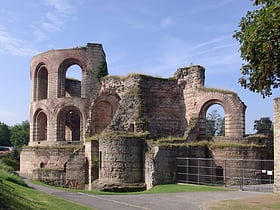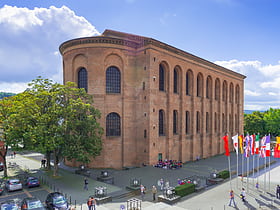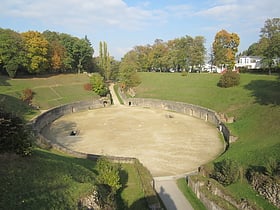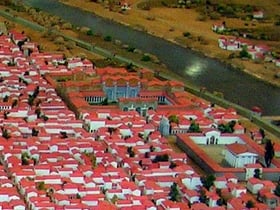Trier: Historical Place
Places and attractions in the Historical place category
Kaiserthermen
Steeped in the rich tapestry of ancient history, the Kaiserthermen, or Imperial Baths, stand as a monumental relic of Trier's Roman past. This historical landmark, nestled in the oldest city in Germany, offers a glimpse into the grandeur of Roman bathing culture...
Aula Palatina
Emperor Constantine's throne hall The Aula Palatina, also known as the Basilica of Constantine, stands as a majestic historical landmark in the city of Trier, Germany. Erected in the early 4th century during the reign of Emperor Constantine, it is a remarkable example of Roman architecture and Imperial...
Amphitheater
Nestled in the historic city of Trier, Germany, the ancient Amphitheater stands as a testament to the city's Roman past. This monumental structure, buried into the side of a hill, once echoed with the roars of gladiators and the cheers of up to 20,000 spectators.
Stadtmuseum Simeonstift
The St. Simeon’s Collegiate Church was a collegiate church in Trier, Germany, near the Roman city gate of the Porta Nigra. Named after the Greek monk, St.
Karl-Marx-Haus
Museum of Karl Marx's life and work The Karl Marx House museum is a writer's house museum in Trier. In 1818, Karl Marx, the father of Marxism, which influenced both modern socialism and communism, was born in the house.
Barbara Baths
The Barbara Baths are a large Roman bath complex in Trier, Germany. It is the largest Roman bath north of the Alps. It is designated as part of the Roman Monuments, Cathedral of St. Peter and Church of Our Lady in Trier UNESCO World Heritage Site. For preservation, the baths are closed to visitors as of 2014.
St. Gangolf
15th-century Roman Catholic church St. Gangolf's Church is a Roman Catholic church in Trier, Germany. It is dedicated to St. Gangulphus. After Trier Cathedral, it is the second oldest church building in the city.
Forum Baths
49.752736°N 6.63766°E The Forum Baths of Trier are a ruin of a Roman bath complex in Trier, Germany. The baths were discovered in 1987.
Dreikönigenhaus
The Dreikönigenhaus in Simeonstraße in Trier, not far from the Porta Nigra, is a patrician house in the form of an early Gothic residential tower. The name dates from around 1680, when Johann Cornet ran the inn "Zu den drei Königen" there.
Rotes Haus
The Red House is located in Dietrichstraße on the market square in Trier. The house was built in 1684 by the master builder Wolfgang Stuppeler for the cathedral secretary Johann Wilhelm Polch.
Hochbunker Augustinerhof
The high bunker Augustinerhof is one of five surviving high -bunkers in Trier.
Map












